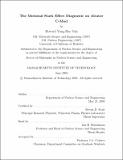The Motional Stark Effect diagnostic on Alcator C-Mod
Author(s)
Yuh, Howard Yung-Hao
DownloadFull printable version (14.18Mb)
Other Contributors
Massachusetts Institute of Technology. Dept. of Nuclear Engineering.
Advisor
Steven D. Scott.
Terms of use
Metadata
Show full item recordAbstract
A ten channel Motional Stark Effect diagnostic has been installed on Alcator C-Mod to measure the plasma internal magnetic pitch angle profile. The C-Mod MSE measures the local electric field direction by measuring the polarization angle of Balmer-[alpha] n=2) emission from a radially injected hydrogen Diagnostic Neutral Beam (50 keV, 5 A, 50 ms). The Lorentz electric field (EL = v ) and the magnetic field cause the nominally fully degenerate Balmer-[alpha] to split into a partially degenerate multiplet whose components are polarized relative to the local fields. Through careful spectral filtering, MSE measures the polarization angle of select multiplet components using a photoelastic modulator based polarimeter. Investigation of hydrogenic Balmer-[alpha] transitions in crossed E and B fields typical of MSE has led to the discovery of new features of the Stark-Zeeman Balmer-[alpha] multiplet. Three different transitions are found for this EB = ( ... ) configuration. In the regime where the Stark effect dominates over the Zeeman effect, transitions polarize parallel to E, B, or ... with ellipticity a function of the beam velocity. More important for MSE diagnostics is the discovery that multiplet lines (summed over degenerate transitions) will be observed to be orthogonally polarized only for statistical (i.e. equally) upper hybrid state populations. (cont.) This contradicts the pure Stark case that is typically assumed for MSE, where Stark- lines are always observed to be orthogonal to Stark-[pi] lines. Non-statistical upper hybrid states populations are expected in certain situations including the propagation of beam neutrals through neutral gas, which is often used to calibrate MSE diagnostics in situ. Implementation of MSE on C-Mod required significant optical and optomechanical engineering. Satisfying MSE viewing geometry requirements for a radial beam on C-Mod resulted in an extended periscope inside the vacuum vessel. A successful design with robust performance against disruption accelerations, fatigue, creep, thermal stresses, and impact while being vacuum compatible has been developed for mounting the necessary polarization preserving optics. Full Stokes polarimeter modeling and calibration has been performed for the C-Mod MSE. An invessel apparatus has been constructed that is capable of generating pure, linearly polarized light absolutely aligned (to gravity) at arbitrary angles,circularly polarized light, as well as unpolarized light. This device has been used in situ to measure the MSE response to all possible Stokes vectors. Results have been compared to a Mueller matrix model of MSE including real geometry and one imperfect mirror with an arbitrary s&p phase shift and s&p reflectivity ratio. (cont.) Geometric and optical properties of MSE have been deduced by matching measured responses with modeled responses. A method for concurrently measuring the PEM retardances has been developed as part of this effort. A complementary calibration technique using DNB injection into a gas-filled torus with known fields capable of measuring in situ optical Faraday rotation was also performed. Results show possible molecular deuterium contamination arising from the fill gas used in the calibration. MSE polarization measurements displayed discrepancies of over 20 with expected values from a vacuum field reconstruction. Motivated by spectral observations, an inclusion of Zeeman polarized D2 molecular emission reconciled measured and modeled values of the linear angle and polarization fraction. Observed on-linearities in angular response and the strong viewing geometry dependency are also reproduced in the model when Zeeman polarized D2 emission is included. Experiments testing this hypothesis are proposed. Pitch angle measurements in plasmas show that MSE has statistical uncertainties of 0.4 for all but the edge channel up to plasma densities of ne = 1.5 x 1020 m-3. This is insufficient to explain remaining discrepancies with magnetic reconstruction results at the plasma edge. While Faraday rotation and PEM retardance changes could play a role, these instrumental effects are also insufficient. Radial electric fields and beam induced charge exchange emission have been suggested as causes for errors in MSE measurements of plasma.
Description
Thesis (Ph. D.)--Massachusetts Institute of Technology, Dept. of Nuclear Engineering, 2005. This electronic version was submitted by the student author. The certified thesis is available in the Institute Archives and Special Collections. Includes bibliographical references (p. 265-271).
Date issued
2005Department
Massachusetts Institute of Technology. Department of Nuclear Engineering; Massachusetts Institute of Technology. Department of Nuclear Science and EngineeringPublisher
Massachusetts Institute of Technology
Keywords
Nuclear Engineering.